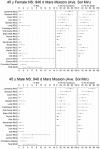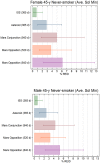How safe is safe enough? Radiation risk for a human mission to Mars
- PMID: 24146746
- PMCID: PMC3797711
- DOI: 10.1371/journal.pone.0074988
How safe is safe enough? Radiation risk for a human mission to Mars
Abstract
Astronauts on a mission to Mars would be exposed for up to 3 years to galactic cosmic rays (GCR)--made up of high-energy protons and high charge (Z) and energy (E) (HZE) nuclei. GCR exposure rate increases about three times as spacecraft venture out of Earth orbit into deep space where protection of the Earth's magnetosphere and solid body are lost. NASA's radiation standard limits astronaut exposures to a 3% risk of exposure induced death (REID) at the upper 95% confidence interval (CI) of the risk estimate. Fatal cancer risk has been considered the dominant risk for GCR, however recent epidemiological analysis of radiation risks for circulatory diseases allow for predictions of REID for circulatory diseases to be included with cancer risk predictions for space missions. Using NASA's models of risks and uncertainties, we predicted that central estimates for radiation induced mortality and morbidity could exceed 5% and 10% with upper 95% CI near 10% and 20%, respectively for a Mars mission. Additional risks to the central nervous system (CNS) and qualitative differences in the biological effects of GCR compared to terrestrial radiation may significantly increase these estimates, and will require new knowledge to evaluate.
Conflict of interest statement
Figures





References
-
- National Research Council (1996) Radiation hazards to crews of interplanetary missions: biological issues and research strategies. The National Academies Press, Washington, DC, 1996.
-
- Cucinotta FA, Schimmerling W, Wilson JW, Peterson LE, Saganti P, et al. (2001) Space radiation cancer risks and uncertainties for Mars missions. Radiation Research 156: 682–688. - PubMed
-
- Cucinotta FA, Durante M (2006) Cancer risk from exposure to galactic cosmic rays: implications for space exploration by human beings. The Lancet Oncology 7: 431–435. - PubMed
-
- National Council on Radiation Protection (2006) Information needed to make radiation protection recommendations for space missions beyond low-earth orbit. National Council on Radiation Protection and Measurements Report No. 153, Bethesda MD.
-
- Cucinotta FA, Kim MY, Chappell L (2013) Space radiation cancer risk projections and uncertainties- 2012. NASA TP 2013-217375.
Publication types
MeSH terms
Substances
LinkOut - more resources
Full Text Sources
Other Literature Sources
Medical
Miscellaneous

